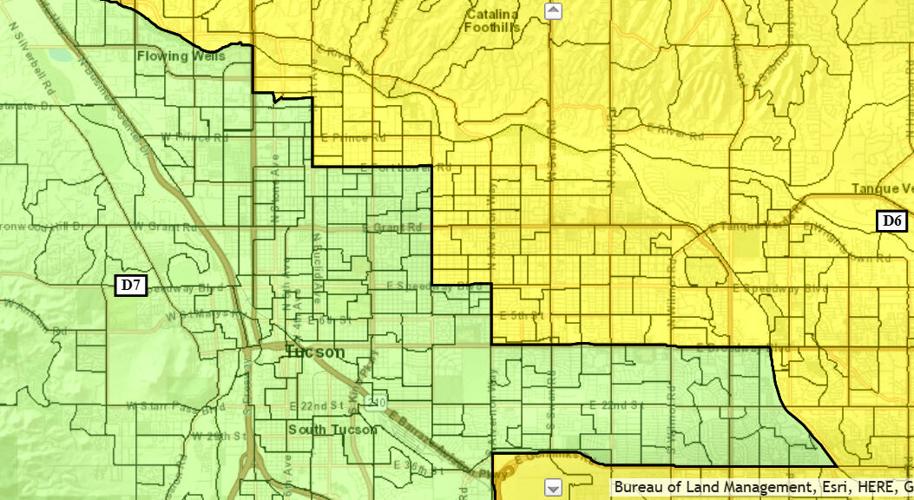PHOENIX — The Independent Redistricting Commission voted unanimously Wednesday to approve new lines for Arizona congressional races through the 2030 election, even though its members complained the final result was not what they wanted.
Commission members said the approved compromise plan was the only real option for a membership that has two Republicans, two Democrats and a political independent.
Wednesday’s vote, however, may not be the last word.
Attorney Marc Elias, who has filed election-related lawsuits across the country on behalf of Democrats, sent a Twitter message shortly before the vote saying he has been watching what is happening here.
“I expect litigation if these illegal maps are enacted,” he wrote.
On paper, using voter registration figures, the maps would create four “safe” congressional seats for Republicans and three for Democrats, with two that are considered competitive.
But Democratic Commissioner Shereen Lerner said voter registration is only one indicator. The new Congressional District 6 is supposedly competitive, but she noted that an analysis of how residents within its boundaries voted in nine prior elections in 2018 and 2020 found that Republicans won six.
Even that, Lerner said, is misleading. Of the three that were listed as Democratic wins in CD6, one was the 2020 U.S. Senate race where Mark Kelly beat Republican Martha McSally, but only with 50.5% of the votes. The other was a win for Joe Biden in the presidential race, who got just a hair over 50%.
The newly approved CD6 stretches from midtown Tucson through Graham and Greenlee counties and most of Cochise County and up into Casa Grande.
The situation is similar in CD1, the other supposedly competitive district, which encompasses parts of northeast Phoenix and Scottsdale. “This is not the map I would like,” Lerner said.
She said it is a deviation from the current political situation where Arizonans have elected Democrats to five of the state’s nine congressional seats.
But Erika Neuberg, the independent who chairs the panel, dismissed the current breakdown of the congressional delegation as irrelevant to the commission’s goals of drawing districts that represent communities of interest, geographic boundaries, federal voting rights laws and competitiveness, with the last factor allowed only to the extent it does not interfere with the others.
“Maybe we see our constitutional responsibilities differently,” she said, saying it is not the role of the commission to start with a presumption of how many Democrats and Republicans Arizona should send to the U.S. House.
While Lerner and fellow Democrat Derrick Watchman voted for the plan as the best they thought they could get, it was panned by the Arizona Democratic Party.
The party’s harshest criticism was reserved for Neuberg, who held the balance of power.
“Despite having changed her registration from Republican to independent in 2016, it is now all too clear that Chair Neuberg is a partisan in sheep’s clothing,” the party’s statement reads. “She has been an active participant in the Republican commissioners’ efforts to achieve a warped congressional map so gerrymandered it might as well have been drawn by a Republican legislature.”
“No comment,’’ Neuberg responded.
Twists and turns in city’s center
Some of the basis for the complaints by the Democrats has to do with how the panel crafted CD6 — and, specifically, how it divided Tucson between that district and already heavily Democratic CD7, which runs all the way west to Yuma and then north into Phoenix’s western suburbs.
Republican David Mehl led multiple efforts to move that line as far east in Tucson as possible.
He said that ensures downtown Tucson is united with the University of Arizona community, which he said runs out as far as Alvernon Way. As evidence, he said that even UA President Robert Robbins lives east of the campus.
That didn’t impress Lerner, who said Michael Crow, president of Arizona State University, lives nowhere near that campus.
“We’re not going to make a whole district around ASU,” she said. “Where the president lives is not a community of interest.”
Lerner saw something more sinister in moving those midtown Tucson voters — a presumably Democratic area — into CD7, where Republicans already stand little chance of electing anyone to Congress.
“When you made those changes in Tucson it was specifically packing District 7 with white, liberal voters and taking them out of District 6,” she complained.
The map approved Wednesday setting the dividing line between congressional districts 6 and 7 takes some interesting twists and turns.
It starts at the Rillito River and turns south on Oracle Road, then east on Limberlost Drive, south on First Avenue, east on Fort Lowell Road, south on Country Club Road, east on Speedway, and south on Alvernon Way to Broadway. It then takes in the area between Broadway and Golf Links Road before turning back to Alvernon.
Everything to the east is in CD6, the one that, depending on whose calculus you use, is either politically competitive or leaning Republican.






